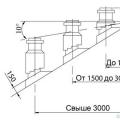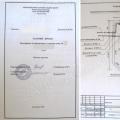Owners of private houses have to solve the problem of water supply for their households on their own. The arrangement of an autonomous source in the form of a well or a well is associated with labor, time and finance costs. Well, if a central water supply line runs nearby, it is most convenient to stretch the pipeline network from it.
In this case, the comfort of living even in an old house is significantly increased, since the normal functioning of the sewage system, heating and other engineering communications will be ensured. You can also carry out water to a private house with your own hands, you just need to collect the necessary documents.
You can connect to the central water supply in winterBenefits of central plumbing
Connecting to the central water supply in comparison with the arrangement of an autonomous water supply system has several advantages. There is no need to purchase expensive pumping equipment, there is no need to drill, pump and maintain the well. In addition, the centralized supply of water is a certified type of activity, so the consumer receives:
- drinking water that meets sanitary and hygienic standards;
- normalized pressure in the pipeline network;
- supply of water almost without interruption.
You can carry out water supply and connect it to the central line yourself, or you can invite specialists. They will help lay the system underground and carry out its supply to the house. Of course, in this case, they will have to pay for their work.
Without documents, it will not be possible to conduct water to a private house
To connect a private house to a centralized water supply, you will have to contact several authorities and obtain permits.
Without them, it will not be possible to use water, and for unauthorized connection there are huge fines and dismantling of equipment at the expense of the owner.
It will be necessary to carry out various studies, draw up technical documentation and approve it in the relevant structures. All stages of paperwork should be completed sequentially, otherwise you will have to start all over again.
First, contact the geodetic service
First, you should contact your local geodetic service. Its employees will perform a topographic survey of the area and draw up a situational plan of the site. All objects located on the ground are applied to it with the indication of the distance between them and the nearest engineering communications.
This is what geodetic survey and technical conditions look likeSurveyors will complete their work within ten days and issue an invoice for the services rendered. If there is a situational plan, more than a year has passed since the preparation of which, you will have to order a new explication, this is another name for this document. When contacting the geodetic service, you will have to present title documents for the use of the land.
We receive technical conditions for connecting to the water supply
To obtain technical specifications for connecting water, the owner of a private house can apply to the authority that issued the permit for the construction of the facility. They will determine which company will provide centralized water supply services to a new user. There you should submit documents, which will have to collect an impressive list. You will need the following:
- confirmation of ownership or use of the house and land;
- owner's identity card;
- seven copies of the explication;
- two copies of the building permit;
- the balance of water consumption prepared by the designers;
- two copies of the application.
The technical conditions, which are provided to the user 14 days after the submission of the package of documents without charging a fee, indicate the dates of connection to the central water supply line and the permissible load on the central water supply of the user in question. The authority that provided the technical conditions undertakes to connect the private house to the central water supply.
Now you can order a water supply project
The specifications have finally been received and the water supply project can now be ordered. Without it, it is impossible to sign an agreement with a company providing centralized water supply services. Based on the developed specifications, the water supply project can be carried out by any competent organization, but in any case, it must be approved by the local water supply and sewerage company.
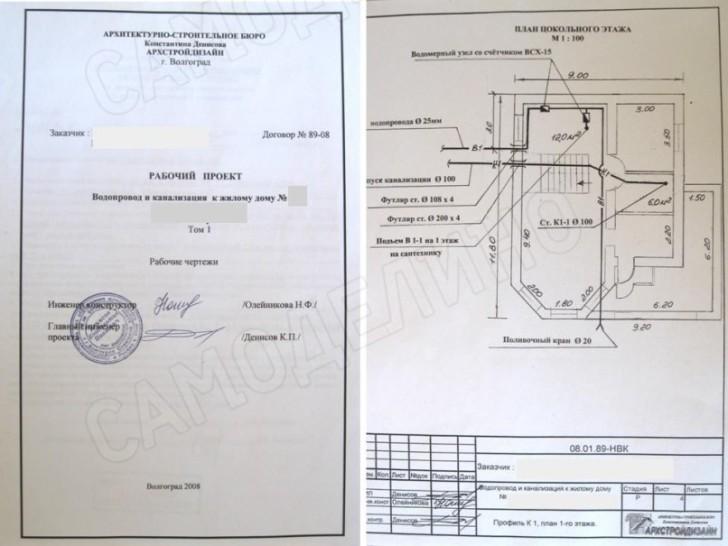 The connection must be made in accordance with the project
The connection must be made in accordance with the project The document will also need to be coordinated with suppliers of electricity, gas, and even with a telephone exchange due to the fact that their engineering communications are also connected to the house, and the water supply network should not interfere with their functioning. The project is finally approved by the architectural committee.
Lay the pipe yourself or contact a licensed organization?
When connecting a private house to a centralized water supply, it must be understood that all earthworks outside the site, according to the rules, must be carried out by an organization that has a license for this. Unfortunately, the latter use their position and charge high prices for their services. The penalty for violation is noticeably less, so many do this work themselves.
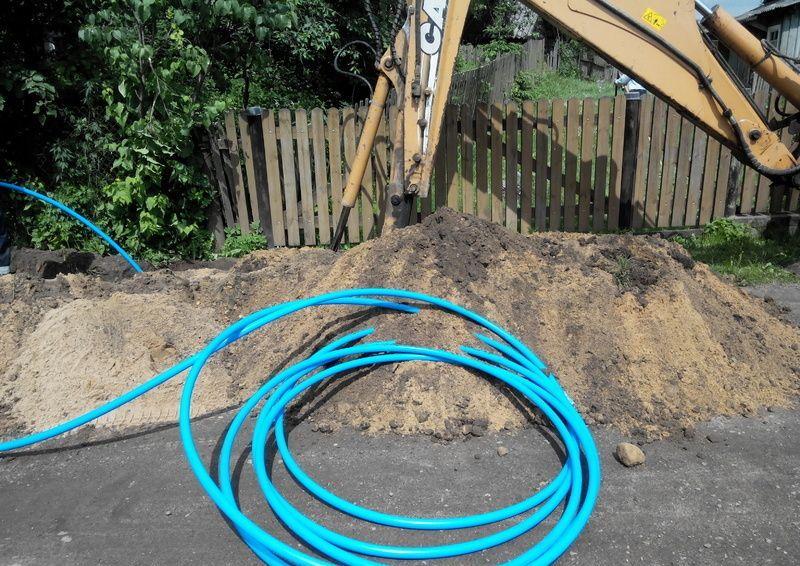 An excavator is clearly more efficient than a shovel
An excavator is clearly more efficient than a shovel The cost of arranging a water supply system consists of payment for the services of installers, the purchase of materials and various fees. The cheapest way to get water is to do all the work yourself, and install the water supply network from pipes made of polyethylene or polypropylene.
We contact the water utility to conclude an agreement
Now you should contact the water utility to conclude an agreement on connecting water supply. Its essence lies in the fact that the organization performs all the necessary actions to prepare and connect the infrastructure of a private house to the central water supply, and the user pays for these services.
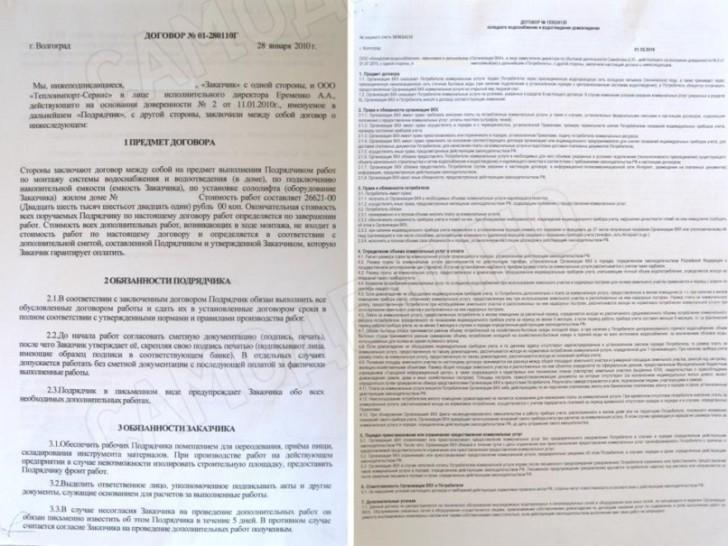 Contracts for works and water supply
Contracts for works and water supply The price is set by the local branch of the water utility, and it consists of a fee for conducting the pipeline system from the house to the point of insertion into the main network and the connected load of the system. The cost of materials and the labor of the assembly team are included in this price.
Do-it-yourself plumbing
It is realistic to save a lot on arranging a water supply system if you do all the work on laying it yourself. First of all, it is necessary to draw up a diagram that indicates the location of pipes and water intake points. When developing it, one should not strive to the heights of engineering, the most important thing is that it is easy to navigate in the scheme, and that it allows you to correct errors made during installation, if any.
The diagram indicates the features of the terrain, the presence of rocky or sandy soil in the area, provides for the area necessary for the implementation of the pipeline interchanges. It should be borne in mind that all installation work must be carried out on a pre-leveled surface, otherwise unpleasant surprises cannot be avoided.
We equip a well at the connection point
At the point of connection to the main water main, it is necessary to equip a well. It is needed in the case when it is necessary to quickly shut off the water supply for repair work, so shutoff valves are installed in it. The well can be laid out of red brick or equipped with concrete rings.
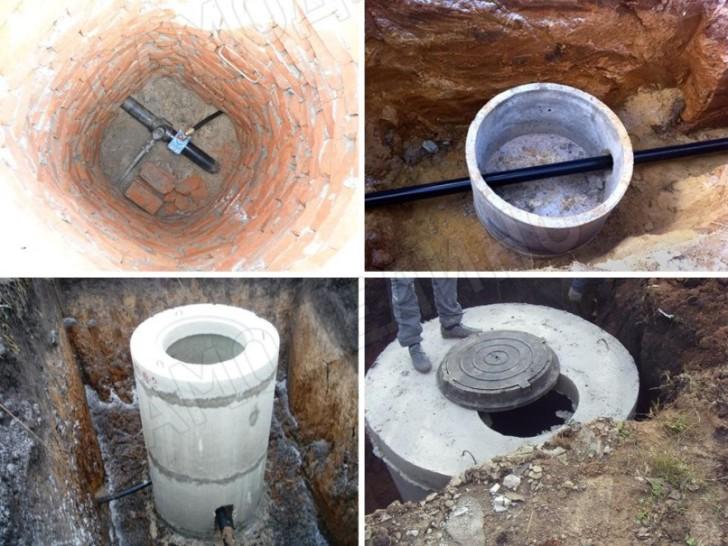 Well options for connecting water supply
Well options for connecting water supply From above the well is covered with a lid. The latter can be made of plastic, but it must be able to withstand the traffic that may pass over its surface. Of course, these worries can be avoided if the well already exists at the connection point.
Connection is carried out by inserting into the central line using welding equipment. It is also possible to connect to the central pipe using a special clamp without the use of welding. Thus, it is possible to connect to both a steel and a plastic pipe, and without turning off the water supply in the central line.
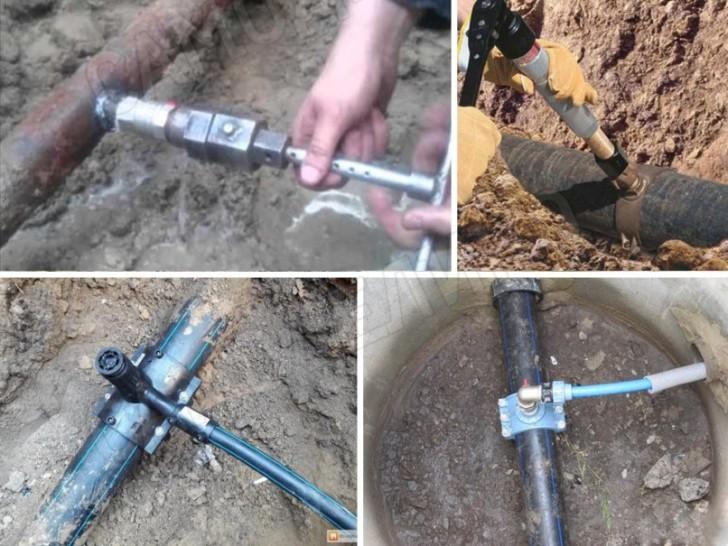 Ways to connect to the central pipe
Ways to connect to the central pipe In this case, the clamp is first securely mounted on the supply pipe, and then it is drilled through the hole in the clamp. An electric drill will not work, as it will flood with water! Then a valve is screwed onto the thread of the clamp in the open state, after which the valve closes. When using a ball valve, drilling can be done after it is installed. Of course, a forced shower is indispensable in this case, so you need to choose the right weather and clothes.
Digging a trench to the desired depth
The greatest laboriousness when connecting a private house to the central water supply is the process of digging a trench. Depending on the distance from the main highway, you can use manual labor or special equipment in the form of an excavator or other earth-moving machine. Of course, you need to understand well at what depth to bring the pipe.
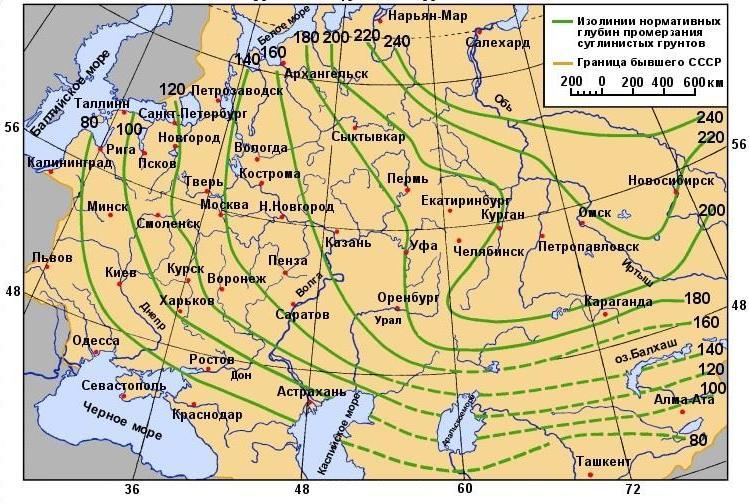 Map of normative freezing depths
Map of normative freezing depths The trench should be dug to such a depth that it is below the freezing point of the soil in the area of work. Otherwise, the water frozen in the pipes will break them, and in the spring everything will have to be started anew. On the contrary, in regions with a mild climate, it is possible to build a highway without digging a trench.
If there are no significant inclusions of stones and clay in the composition of the soil, work is facilitated. Several holes can be dug along the line, and the earth bridges between them can be destroyed using a high-pressure water jet supplied from a hose. This technique significantly reduces the cost and facilitates excavation.
 It is more convenient to dig a trench to the house with shovels
It is more convenient to dig a trench to the house with shovels Sometimes, due to too heavy soil, it is difficult to dig a trench of the required depth. Modern insulation materials can help here, with the help of which the thermal insulation of the pipeline system is performed. In any case, going deep into the ground, at least a hundred centimeters, is still necessary.
At the bottom of the dug trench, a pillow is arranged before laying the pipes. It is a mound of sand and gravel, creating a shock-absorbing pad. In addition, it allows you to divert soil water from the pipeline, thereby preventing its icing. Now you need to decide how best to lay the pipe underground and bring it under the foundation.
We pass the foundation and make an entrance to the house
The introduction of the pipeline into the house is often carried out under the foundation. In this case, the question of the depth of laying the pipe and the need for its insulation is solved in the same way as for the entire water supply line laid outside the house.
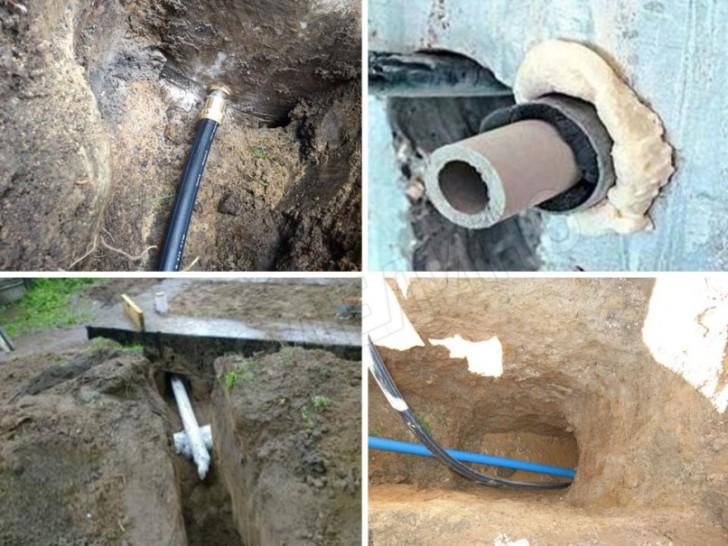 Options for introducing pipes into the house
Options for introducing pipes into the house The entry of the pipeline into the house can also be carried out through the foundation, which will require making a hole. Particular attention should be paid to this element of the pipeline network if there is a section that is not deep in the ground and, as a result, is at high risk of freezing. Be sure to perform high-quality thermal insulation of this pipe section.
The diameter of the inlet should be made larger than the cross section of the water pipe by about fifteen centimeters. This is necessary in order to prevent the destruction of the pipeline network if, over time, the walls of the house begin to sag.
We choose the best pipe and lay the eyeliner to the house
Pipes are the most significant element of the plumbing. There are several options and you need to decide which pipes are best suited for installing plumbing and bringing it to the house. In principle, galvanized steel pipes are suitable. Products made of this material tolerate mechanical overloads well, but are susceptible to corrosion processes.
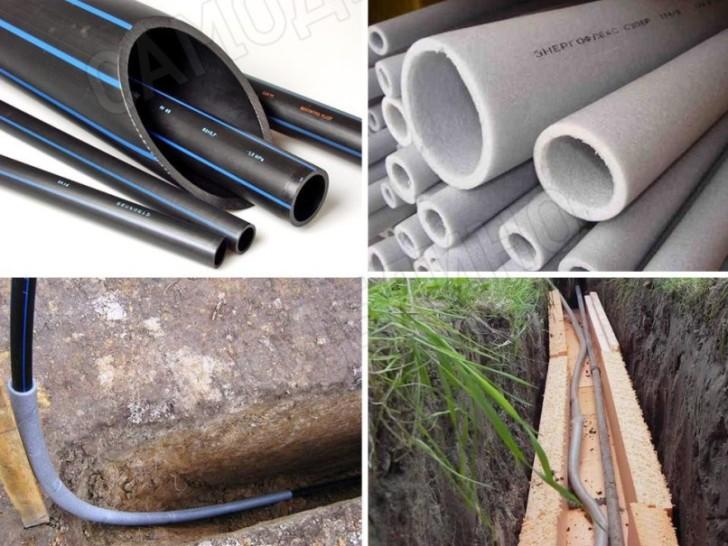 Plumbing pipe and related insulation
Plumbing pipe and related insulation Copper pipes can function for decades, but they are very expensive and difficult to install, so they are used quite rarely. The most widespread are inexpensive pipes made of polymeric materials, easy to install and not afraid of exposure to aggressive chemical environments.
Having completed the pipeline network to the house, you do not need to immediately fill up the trench. First, you should make a test run and carefully examine all butt joints. Faults found must be corrected.
Some features of water use
The pressure in the line is also not always maintained at the desired level. This is where a booster pump can help. Everyone knows that water supply cuts often occur for various reasons. In this case, the installation of a storage tank helps out.
 Useful equipment for owners of water from the central water supply
Useful equipment for owners of water from the central water supply Last tip - think about leak protection.
According to the law of philosophy, quantity develops into quality, that is, a large number of pipes, connections, taps, appliances and, in particular, flexible hoses in a modern home leads to a noticeable increase in the possibility of water leakage.
In the event that this happens in your absence, the cost not only for repairs, but for the actual water will not seem small to anyone! The cardinal solution is to simply turn off the central tap before leaving the house. Of course, there are other flexible and technological solutions to this issue.



